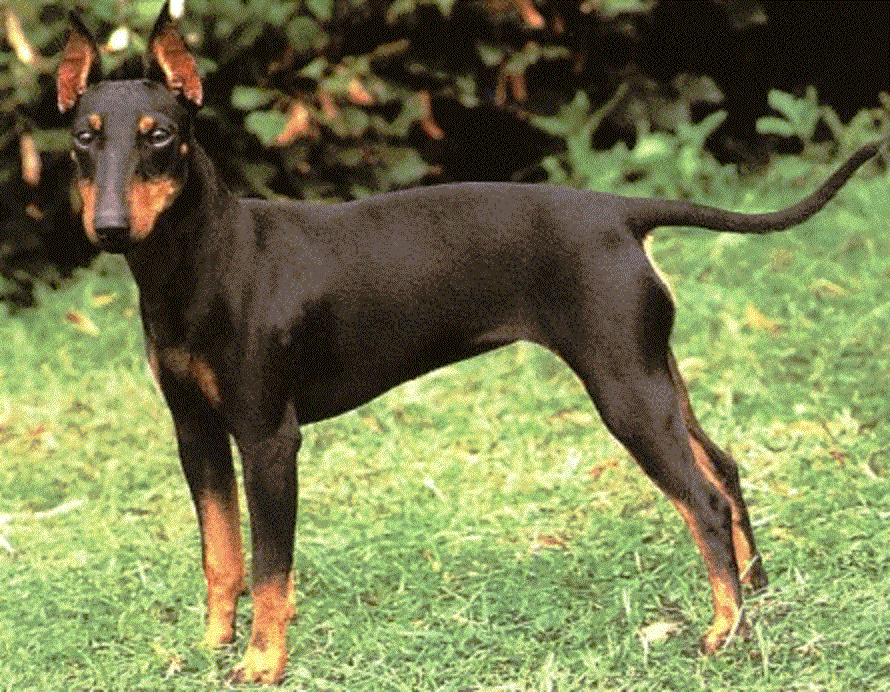
Manchester Terrier

Navigate through the tabs
Navigate through the tabs below to view the breed's info of your interest.
The breed's info is divided in four sections; namely:
the breed's history ,
the breed's main stats ,
the dog's potential health issues
and finally, how the breed scored in 26 different categories.
All the above information should give you a respectively good overview for the dog of your interest.
Dog Breed's Main Info
The Breed's History:
Many people think that Manchester Terriers are small versions of Dobermans. Louis Doberman used Manchesters to breed the larger Doberman, and Miniature Pinscher experts say their breed has no shared heritage.
Manchester Terriers are considered by many to be the oldest of all identifiable terrier breeds. They are mentioned in books dating back to the early 16th century.
Manchester Terriers served an important function in England. In the early 1800s, sanitation was poor and rats were a health menace. Rat killing was a popular sport, and an enthusiast named John Hulme reportedly crossed a Whippet with a Black and Tan Terrier to produce a dog that would excel at it.
Even after the sport was banned, the little Terriers had plenty of work to do in the country's public inns, most of which were infested with rats. Inns often kept kennels of the terriers, and after closing for the night, workers would turn them loose in the dining halls to snatch the rats.
The breed developed a reputation for having great spirit and determination when facing a foe, even ones twice their size. Billy, a Manchester from the 1820s, is still remembered for having killed 100 rats in only 12 minutes. The practice of ear cropping began to eliminate the risk of ears being torn in fights.
The Manchester District of England was the center of breeding by the mid-1800s for these little Terriers, so the Manchester name was bestowed upon them. The public wanted dogs of even smaller stature, so some breeders crossed their dogs with Chihuahuas to further reduce their size.
This caused numerous problems - most notably thin coats, apple heads, and bulging eyes.
The very small Manchesters, although delicate and unhealthy (and as small as two and a half pounds), were popular for many years during the Victorian era. Some owners had specially designed leather pouches made to suspend from their belts to take with them when they rode their horses, earning them the nickname "Groom's Pocket Piece". Even the smallest Manchester Terriers retained their fighting spirit, however.
In 1937, the British Manchester Terrier Club was formed. Its members were instrumental in saving the breed from extinction following World War II.
Country of Origin:
England
Breed Group:
Terrier
Height:
1 foot, 3 inch. to 1 foot, 4 inch. (20,32 to 35,56 cm)
Weight:
12 to 22 pounds (2,26 to 9,08 Kg)
Life Span:
14 to 16 years
Potential Health Issues:
Von Willebrand's Disease,
Glaucoma,
Heat Bumps,
Hip Dysplasia,
Elbow Dysplasia,
Hypothyroidism
Adaptability
Apartment Living:
First Time Owners:
Sensitivity:
Being Alone:
Cold Weather:
Hot Weather:
Friendliness
Affection With Family:
With Kids:
With Dogs:
With Strangers:
Health and Grooming
Shedding:
Drooling:
Easy To Groom:
Overall Health:
Weight Gain Potential:
Size:
Training
Easiness:
Intelligence:
Mouthiness:
Prey Drive:
Barking or Howling:
Wanderlust:
Need For Exercise
Energy Level:
Intensity:
Exercise Needs:
Playfulness:
Our Mobile Application
Check out Our Mobile Application "Dog Breeds Central"
